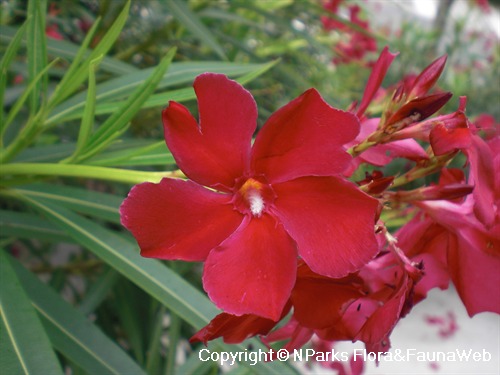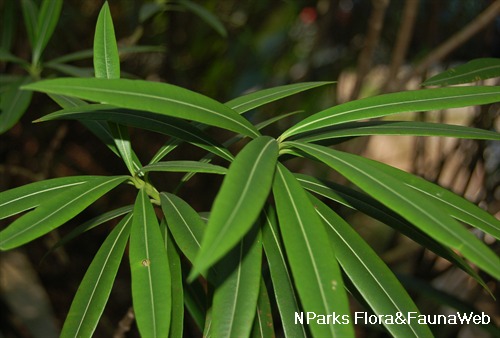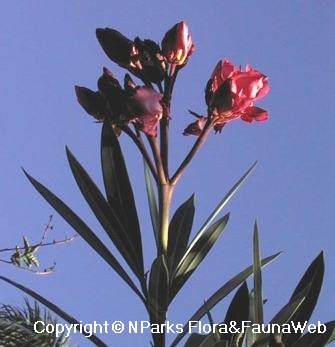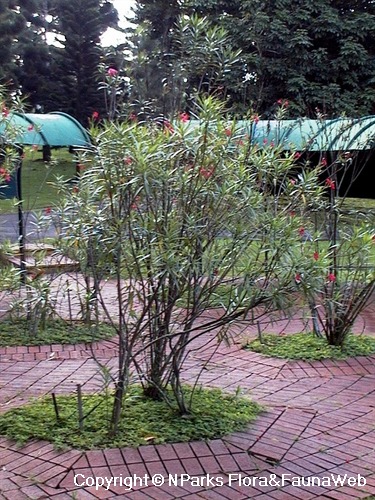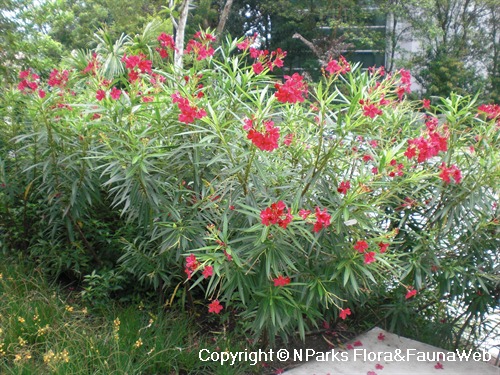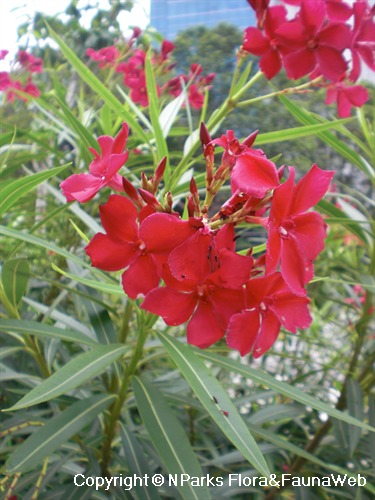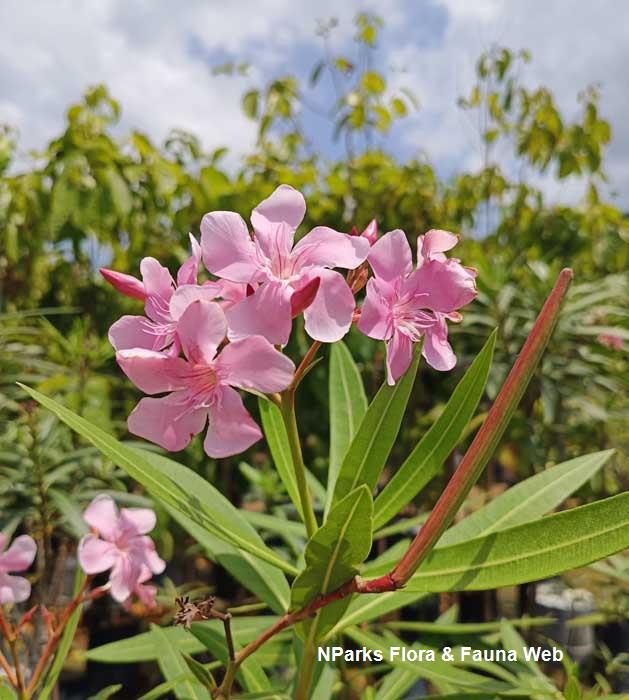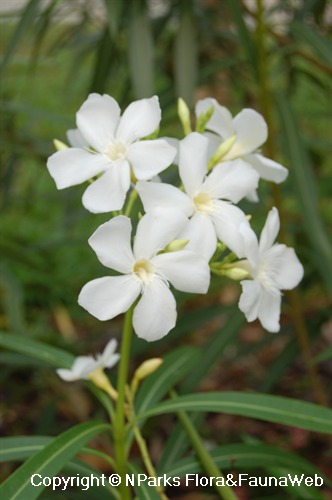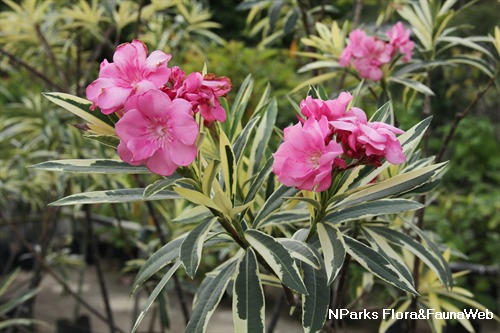.jpg)
Back
Nerium oleander L.
| Family Name: | Apocynaceae |
| Common Name: | Oleander, Rose Bay, Rose Laurel, Dog Bane, Scented Oleander, South Sea Rose, Sweet Oleander, Bunga Anis, Bunga Jepun, 欧洲夹竹桃 |
Oleander is an evergreen shrub with thick and pointy leaves arranged in pairs or whorls of 3 along the stem. This fast-growing tropical shrub produces clusters of reddish 5-petalled flowers at the end of branches and are sweetly scented.
Name
Classifications and Characteristics
| Plant Division | Angiosperms (Flowering Seed Plants) (Dicotyledon) |
|---|---|
| Plant Growth Form | Shrub |
| Lifespan (in Singapore) | Perennial |
| Mode of Nutrition | Autotrophic |
| Plant Shape | Shrubby |
| Maximum Height | 6 m |
Biogeography
| Native Distribution | Cultivated in the Mediterranean |
|---|---|
| Native Habitat | Terrestrial |
| Preferred Climate Zone | Tropical |
| Local Conservation Status | Non-native (Horticultural / Cultivated Only) |
Description and Ethnobotany
| Growth Form | Large woody shrub, up to 6 m tall but usually about 1.5 - 3 m, can be pruned into small tree. |
|---|---|
| Foliage | Leaves glossy and thick, with prominent mid-rib. Leaves lanceolate, arranged in pairs or whorls of 3 along woody stem. |
| Flowers | Flowers fragrant, bright red and showy, 5 petals, in clusters, on the end of each branch. |
| Fruit | Fruits are small narrow capsules, drooping and pod-like, split when dry to release fluffy seeds. Seeds dispersed by wind. |
| Habitat | Found growing along river banks or on poor soils. |
| Cultivation | Cultivated along roadsides and in parks in Singapore. Able to grow in both dry and wet conditions. |
| Etymology | Genus name derived from Greek 'nerion' meaning moist, as plant likes moist soils. Species epithet 'oleander' refers to leaves which resemble olive leaves. |
| Ethnobotanical Uses | Medicinal: One of the glycosides, oleanderin, used to treat patients with heart problems. Decoction of bark and leaves grounded in oil used to treat skin diseases. Leaves boiled in water and drank to cure malaria, induce abortions and reduce swellings. Flowers used to relieve headaches. |
Landscaping Features
| Desirable Plant Features | Fragrant (Flowers) (Day), Ornamental Flowers |
|---|---|
| Landscape Uses | General, Parks & Gardens, Small Gardens |
| Usage Hazard - Cons | Toxic Upon Ingestion, Weak Branches |
| Usage Hazard - Cons Remarks | Cut surfaces secrete cream-coloured latex containing toxins called glycosides. All parts are poisonous, even when dried. Ingestion can cause adverse gastrointestinal and cardiac effects. Avoid planting at areas within reach of children. |
Fauna, Pollination and Dispersal
| Fauna Pollination Dispersal Associated Fauna | Butterfly Host Plant |
|---|---|
| Seed or Spore Dispersal | Abiotic |
Plant Care and Propagation
| Light Preference | Full Sun |
|---|---|
| Water Preference | Moderate Water |
| Plant Growth Rate | Fast |
| Rootzone Tolerance | Poor Infertile Soils, Drought Tolerant, Well-Drained Soils |
| Maintenance Requirements | Low |
| Propagation Method | Seed, Stem Cutting |
Foliar
| Foliage Retention | Evergreen |
|---|---|
| Mature Foliage Colour(s) | Green |
| Mature Foliage Texture(s) | Leathery |
| Foliar Shape(s) | Non-Palm Foliage (Lanceolate) |
| Foliar Margin | Entire |
Floral (Angiosperm)
| Flower Colour(s) | Red |
|---|
Fruit, Seed and Spore
| Fruit Type | Dehiscent Dry Fruit |
Image Repository
Others
| Master ID | 970 |
|---|---|
| Species ID | 2264 |
| Flora Disclaimer | The information in this website has been compiled from reliable sources, such as reference works on medicinal plants. It is not a substitute for medical advice or treatment and NParks does not purport to provide any medical advice. Readers should always consult his/her physician before using or consuming a plant for medicinal purposes. |

.jpg)
